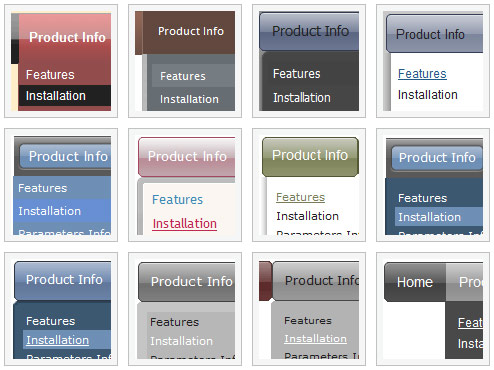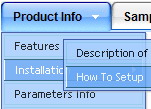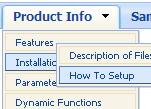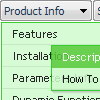Recent Questions
Q: How change the color of the link in the dhtml vertical menu if the link is already visited.
A: Deluxe Menu has only two states normal and mouseover,
butyou can highlight menu items in two ways:
Try to do the following things:
- delete var pressedItem=1; parameter from your data file
- set correct parameter on each page before you call data file, forexample:
<noscript><a href="http://deluxe-menu.com">Javascript Menu by Deluxe-Menu.com</a></noscript>
<script type="text/javascript"> var dmWorkPath = "menudir/";</script>
<script type="text/javascript" src="menudir/dmenu.js"></script>
<script type="text/javascript"< var pressedItem=3;</script>
...<script type="text/javascript" src="menudir/data.js"></script>
You can also set a pressed item using Javascript API:
function dm_ext_setPressedItem (menuInd, submenuInd, itemInd, recursion)
Sets a current pressed item.
menuInd - index of a menu on a page, >= 0.
submenuInd - index of a submenu, >= 0.
itemInd - index of an item, >=0.
recursion = true/false - highlight parent items.
But notice, to use dm_ext_setPressedItem() you should know ID of selected item and subitem.
You can't get this ID after you reload your page. That is why you should write your own code on PHP.
You can find more info here:
http://www.deluxe-menu.com/highlighted-items-sample.html
Q: Is there any way I can do the opposite and make the space my separators take up only a few pixels high? At present I can only make them the same height as the other buttons even though the separator image is only 2 pixels high.
A: You should set a separator in the menuItems, for example:
var menuItems = [
["Home","index.cfm", , , , , , , , ],
["-"],
["About Us","about.cfm", , , , , , , , ],
];
Please, see the following parameters:
//--- Separators
var separatorImage=""; //for subitems
var separatorWidth="100%";
var separatorHeight="3px";
var separatorAlignment="right";
var separatorVImage="images/public/separator.gif"; //for the top items
var separatorVWidth="100%";
var separatorVHeight="2px";
var separatorPadding="";
Q: Can you tell me what fields control the lines around the top level of menu items?
What fields control the lines around each sub-menu item?
I would like to test and see if the program will allow me to create a top menu that displays as follows:
Home | Proposal Reponses | Marketing Info |
As you can see I would like no borders around the top level and a tilda (vertical line) separator between each top level menu item.
For the sub-menu items I would like there to be a thin line box around the sub-menu but no lines in between each item within the sub-menu. What fields control these paramenters?
A: Home | Proposal Reponses | Marketing Info |
Yes, you can create such menu.
Please, use Individual styles.
Set these parameters:
var menuBorderWidth=1;
var menuStyles = [
["menuBorderWidth=0"], //style 0
];
["Home","testlink.html", , , , , , "0", , ], //style 0
["Product Info","", "default.files/icon1.gif", "default.files/icon1o.gif", , , , , , ],
To add lines between main items you can paste the separators.
Please, see the following parameters:
//------- Separators -------
var separatorWidth = "10";
var separatorHeight = "20";
var separatorAlignment = "center";
var separatorImage = "C";
var separatorVWidth = "150";
var separatorVHeight = "10%";
var separatorVImage = "image.jpg";
You can create separators using menuItems, for example:
var menuItems = [
["item 1"],
["-"], // this item is separator
["item 2"],
];
Q: I recently downloaded the trial version of Deluxe Menu-Deluxe Tree and Deluxe Tabs. I am very, very pleased with your product!! I wish to purchase Deluxe Menu & Tree & Tabs & Popup Window & Calendar Single Website License Product # 300094393.
However, before I do, I have a few questions first.
Question #1
I created a DeluxeTree Menu that is very large due to the amount of pages in my website and tested it on my website. It works fine. Of course I have created and saved a .js file and still have to add much more submenus to it. When I purchase the full version of javascript context menu will and begin to modify this .js file that I created will the "Trail Version" logo disappear? I hope so because it would be quite a task to have to re-create this file.
Question #2
I also created a Deluxe Menu in a cross frame structure and placed the menu in the top frame. When I tested it and click on the menu button, the submenus drop down but do not appear in the frame below. They remain in the top frame forcing me to resize the top frame to see the submenus. When I viewed the example on your website for the cross frame structure, the examples show the submenus overlapping and appearing on the frame below the top frame. How do I fix this?
Thank you for time, looking forward to purchasing your product.
A: 1) There is no need to create your javascript context menu after the purchase.
You'll use new engine files only.
The purchased version of Deluxe Menus doesn't have nag messages.
You'll see "Incorrect Key" message on a local machine but you won't see it on a registered domain.
2) You should install the menu in a cross-frame mode, see more info here:
http://www.deluxe-menu.com/cross-frame-mode-sample.html
Click "Show additional info" button.












